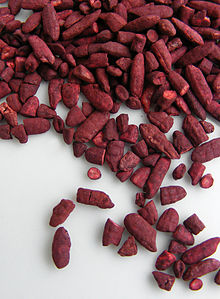- Monascus purpureus
-
Monascus purpureus Scientific classification Kingdom: Fungi Division: Ascomycota Class: Eurotiomycetidae Order: Incertae sedis Family: Monascaceae Genus: Monascus Species: M. purpureus Binomial name Monascus purpureus
(Went, 1895)Monascus purpureus (syn. M. albidus, M. anka, M. araneosus, M. major, M. rubiginosus, and M. vini; simplified Chinese: 红曲菌; traditional Chinese: 紅麴菌; pinyin: hóng qú jùn, lit. "red yeast") is a species of mold that is purplish-red in color. It is also known by the names ang-khak rice mold, corn silage mold, maize silage mold, and rice kernel discoloration.
This fungus is most important because of its use, in the form of red yeast rice, in the production of certain fermented foods in China. However, discoveries of cholesterol-lowering statins produced by the mold has prompted research into its possible medical uses. It produces a number of statins. The naturally occurring lovastatins and analogs are called monacolins K, L, J, and also occur in their hydroxyl acid forms along with dehydroxymonacolin and compactin (mevastatin). The prescription drug lovastatin, identical to monacolin K, is the principal statin produced by Monascus purpureus. Only the open-ring (hyroxyl acid) form is pharmacologically active.
The related fungi Monascus ruber and Monascus pilosus are also used in industrial applications.
See also
External links
- Index Fungorum page (synonyms)
- Index Fungorum page (general)
- Monascus purpureus page
- Website about medicinal use of Monascus purpureus
Categories:- Eurotiomycetes
- Eurotiomycetes stubs
Wikimedia Foundation. 2010.

